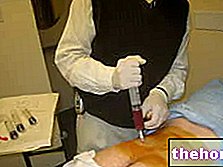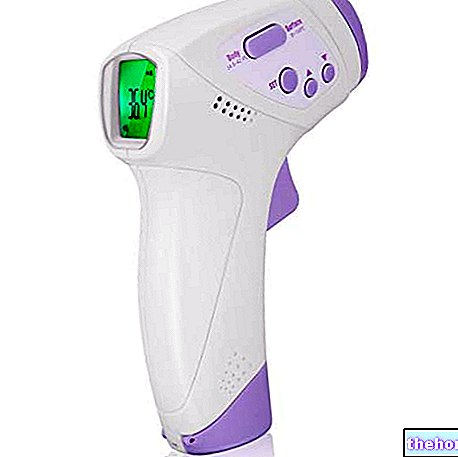Generality
Mastocytosis is a disease characterized by the accumulation of mast cells in various organs and tissues of the body. Once accumulated, these immune cells release significant amounts of histamine.
The histamine produced by mast cells has numerous consequences, sometimes even very serious. The symptoms of the disease are however various and depend on the type of mastocytosis.

Diagnosis requires careful examinations and specific tests. Once the type of mastocytosis has been identified, the most appropriate therapeutic path can be planned; therapeutic path that does not allow healing from the disease, but only improves the symptomatological picture.
What is mastocytosis?
Mastocytosis is a rare pathological condition characterized by an excessive accumulation of mast cells in certain organs and tissues of the body.
WHAT ARE MASTOCYTES?
Mast cells, or mast cells, are a group of cells belonging to the immune system that defend the body from pathogens and other types of threats.
When the human organism is attacked by germs (viruses or bacteria), mast cells begin to release a nitrogenous chemical compound, called histamine, into the blood vessels. Inside mast cells this substance is enclosed in intracellular granules together with other elements; not surprisingly, the histamine release process is known as mast cell degranulation.
Histamine is a vasodilator, therefore its release increases the permeability of the blood vessels, with which it comes into contact. A greater vascular permeability, in a certain point, favors the influx of other immune cells, having a very specific role: attack and remove infesting pathogens from the organism.
This process is part of that very special defense mechanism called inflammation.
What Happens When Mast Cells Don't Work Properly?

Figure: a mast cell containing histamine granules (in purple).
Sometimes, mast cells may trigger a massive release of histamine even when the organism encounters harmless elements, such as pollen and not exactly infectious agents. The resulting inflammatory process has no purpose, as there are no germs to attack, but it still has effects and causes: skin redness, skin swelling, breathing difficulties, itching and rhinitis.
This aberrant mechanism is at the basis of allergic reactions (or allergies), and when it becomes particularly intense it is called anaphylaxis.
TYPES OF MASTOCYTOSIS AND EPIDEMIOLOGY
Two types of mastocytosis have been recognized:
- Cutaneous mastocytosis. Symptoms only affect the skin, because this is where mast cells accumulate; it usually affects children, so much so that it takes the alternative name of pediatric mastocytosis. Among the two existing types of mastocytosis, it is the most common form, although it should be noted that it is, however, a fairly rare disease. In fact, it affects one in 1000 people.
- Systemic mastocytosis. The accumulation of mast cells can occur in any part of the body, therefore skin, any organ (liver, spleen, bone marrow, etc.) and bones. It is a very rare disorder, which mainly affects adults. According to an Anglo-Saxon statistic, he falls ill. of systemic mastocytosis one person in 150,000.
Causes
The accumulation of mast cells in various parts of the organism causes an intense release of histamine and other chemical mediators (also contained in mast cells); the latter, together with histamine, are the creators of all the typical symptoms of mastocytosis.
WHAT CAUSES IT?
The cause or causes, which trigger the onset of mastocytosis, have not yet been fully clarified. The only certain thing is that, at the origin of the disorder, there is a genetic error. This certainty comes from the fact that the DNA of people with mastocytosis has a mutation in the c-KIT gene.
MUTATION OF THE C-KIT GENE: HEREDITARY OR SPONTANEOUS?
The researchers, after years of studies, have come to the conclusion that a part of mastocytosis patients inherits the mutated c-KIT gene from their parents, while a "other part develops the genetic mutation spontaneously and without an (for now) explainable reason. .
Symptoms and Complications
Cutaneous mastocytosis presents symptoms and signs different from those typical of systemic mastocytosis. Therefore, the symptoms depend exclusively on the type of mastocytosis that is in progress.
SKIN MASTOCYTOSIS
As you can guess from the name itself, the most characteristic symptom of cutaneous mastocytosis is the appearance of lesions and abnormalities on the skin.
These skin lesions can be:
- Small areas of different colored skin. These are also called macules.
- Small stable pads of the skin. They are also called papules.
- Reliefs of the skin of considerable size and red color. These are the so-called nodules.
- Extensive raised areas of skin, noticeable only to the touch. These are also identified with the term plaques.
- Blisters, which are collections of subcutaneous fluid.

Figure: cutaneous mastocytosis, in a teenager
The lesions usually appear only on the trunk and have a color that can vary from light yellow-brown to deep red-brown. Their dimensions are extremely variable: they can measure one millimeter in diameter, but also several centimeters.
Equally variable, moreover, is their number: some patients show only one / two lesions, others show a thousand.
Eventually, the affected areas of skin develop swelling, itching and redness of the skin.
SYSTEMIC MASTOCYTOSIS
The presence of an exaggerated number of mast cells in different organs and tissues of the body can cause a very large number of ailments, such as:
- Stomach pain, caused by continuous peptic ulcers. Peptic ulcers are the natural consequence of the excessive release of histamine in the stomach.
- Enlarged liver (hepatomegaly) and subsequent jaundice. All this causes a sense of apathy
- Enlarged spleen (splenomegaly) and subsequent abdominal pain
- Joint pain
- Enlarged lymph nodes
- Sense of weakness
- Extreme fatigue, even in doing less strenuous activities
- Mood swings, such as irritability and sudden confusion, and amnesia
- Loss of appetite
- Weight loss
- Osteoporosis and bone pain.
- Need to urinate often
In addition, systemic mastocytosis is also characterized by the appearance of:
- Repeated hot flashes. This is a different sensation from that caused by heavy sweating.
- Palpitations, which is an irregular heartbeat.
- Stun. The patient feels severe dizziness.
- Hypotension, or drop in blood pressure, with all its consequences (blurred vision, fainting, general malaise, etc.).
- Headache, shortness of breath, chest pain, nausea and diarrhea.
These symptoms, particularly hot flashes, palpitations and confusion, appear suddenly in the form of attacks lasting 15-30 minutes. After this period of time, they gradually disappear, only to reappear at a later time.
The attacks are very often subsequent to physical exertion, the intake of certain drugs (aspirin or antibiotics), emotional stress, the ingestion of particular foods and spices, alcohol intake and infectious diseases such as flu and cold.
Subtypes of systemic mastocytosis
Based on the severity and the organs and tissues affected, three different subtypes of systemic mastocytosis could be distinguished. These are indolent systemic mastocytosis, aggressive systemic mastocytosis and systemic mastocytosis associated with a blood disorder. In 90% of cases, those suffering from systemic mastocytosis are affected by the indolent form, which is characterized by moderate and variable symptoms.
ANAPHYLAXIS
Individuals with mastocytosis, both systemic and cutaneous, are the protagonists, more than healthy people, of episodes of anaphylaxis. Anaphylaxis, as we have seen, is an allergic reaction caused by a reckless and unreasonable release of histamine by mast cells.
The reason for this greater predisposition is most likely due to the massive presence of mast cells in the various tissues and organs.
Typical symptoms of anaphylaxis
- Respiratory difficulties
- Swelling of the eyes, lips, hands and other areas of the body
- Itchy skin and itchy rash
- Strange metallic taste in the mouth
- Red, itchy and inflamed eyes
- Changes in heartbeat
- Sudden sense of anxiety
- Hypotension
- Sense of vomiting and diarrhea
- Fever
Diagnosis
Cutaneous mastocytosis and systemic mastocytosis each have their own symptoms, consequently they are diagnosed with different examinations and tests.
SKIN MASTOCYTOSIS
Cutaneous mastocytosis causes, as seen, evident cutaneous signs (ie lesions).
Therefore, first of all, we begin with a physical examination, during which the doctor (usually a dermatologist) analyzes the appearance and size of the lesions. These are important characteristics, because they are typical of cutaneous mastocytosis: the reddened appearance of the skin of the trunk and the sensation of itching at the affected area.
The second step consists in a biopsy, which definitively establishes what the marks on the skin detected by the physical examination are due to. The biopsy involves the taking and microscopic analysis of a small sample of pathological skin tissue ( i.e. suffering from papules, nodules, etc.). If, from the observation under the microscope, it emerges that the sample contains a very high number of mast cells, then it is a cutaneous mastocytosis.
SYSTEMIC MASTOCYTOSIS
To establish the correct diagnosis of systemic mastocytosis, the following 5 tests must be performed in sequence:
- Blood exam completed. This is the count of all the cells and other elements present in the blood. It requires the taking of a blood sample from a vein in the arm and its careful analysis. If, at the end of the tests, a strangely low level of blood cells emerges, it could mean that there is an excessive presence of mast cells in the bone marrow (N.B: the bone marrow is the organ that produces blood cells).
- Analysis of blood tryptase levels. Tryptase is an enzyme present only inside mast cells, precisely in the granules. Therefore, if there is a "high amount of tryptase in the blood of an individual, it means that, almost certainly, there is a high number of circulating mast cells." The quantification of tryptase levels is achieved with a special blood test.
- Abdominal ultrasound. It is a non-invasive radiological examination, which provides clear images of the internal organs of the body. In patients with suspected systemic mastocytosis (complete blood count and positive tryptase level analysis), this is done to see if the liver and spleen are enlarged.
- DEXA (dual energy X-ray absorptiometry). It is an X-ray test, which allows you to measure the levels of calcium in the bones of an individual. In the case of systemic mastocytosis, the bones are poor in calcium and subject to osteoporosis, as they are "infested" by an excessive number of mast cells, which produce corrosive substances.
- Bone marrow collection and analysis. The bone marrow is found in the innermost areas of some bones. Therefore, the collection of a sample requires a syringe with a very long needle and a small local anesthesia, to be practiced where you intend to insert the needle.
Figure: bone marrow harvest Once the necessary quantity of marrow has been removed, the cells contained therein are analyzed. In the bone marrow of an individual with systemic mastocytosis, a high quantity of mast cells is observed.
Treatment
Although there is no cure for mastocytosis, it is possible to resort to therapy aimed at improving symptoms.
This therapy depends on two factors: on the type of mastocytosis, whether cutaneous or systemic, and on the severity of the symptoms.
It is based almost exclusively on the administration of drugs of various kinds, some more effective and powerful than others.
CORTICOSTEROIDS FOR TOPICAL USE
Topical corticosteroids are available in the form of creams, ointments, and ointments. They are used by people with moderate cutaneous mastocytosis. Their action consists in preventing the release of histamine, anticipating, in fact, the triggering of the subsequent inflammatory process.
The side effects caused by topical corticosteroids are:
- Skin thinning and striae on the skin
- Skin discoloration
- Ease of the treated area to develop hematomas
To better limit the side effects, it is recommended to apply the drug exclusively where there are skin lesions.
ANTIHISTAMINS
Antihistamines, as their name suggests, block the effects of histamine.
They are administered both in case of cutaneous mastocytosis and in case of indolent systemic mastocytosis and are used for the treatment of skin itching and redness.
The possible side effects are: headache, dry mouth and dry nose. All three pass very quickly.
SODIUM CHROMOGLICATE
Sodium cromoglycate is a drug usually used to treat allergic reactions triggered by certain foods and those that cause itchy eyes and rhinitis. Its therapeutic action is linked to the ability to reduce the amount of substances released by mast cells.
The symptoms, on which it seems to have the greatest effect, are: joint pain, a sense of weakness, headache and itching.
PUVA
PUVA consists in the administration of a particular drug, called psoralen, and in the subsequent exposure of the patient to ultraviolet rays type A (UVA light). Psoralen increases the skin's sensitivity to the effects of UVA light, which helps remove skin lesions.
PUVA is a treatment which, if used for long periods of time, could lead to the appearance of skin cancers. For this reason, it is practiced only in case of severe cutaneous mastocytosis and for a limited number of sessions.
CORTICOSTEROIDS IN TABLETS
Corticosteroids in tablets are given to patients with mastocytosis who suffer from very intense itching and / or severe pain in the bones.
The side effects are different and, in some cases, even very serious; therefore it is good not to abuse it.
Some side effects of corticosteroids in tablets:
- Weight gain
- Water retention
- Increased appetite
- Hypertension
- Irritability
BIPHOSPHONATES AND SOCCER SUPPLEMENTS
Bisphosphonates, associated with calcium supplements, are administered to patients with mastocytosis suffering from osteoporosis. Their effect, in fact, is to slow down the destruction of the bone tissue and favor the opposite process, namely the construction process.
H2 RECEPTOR ANTAGONISTS
H2 receptor antagonists are indicated for the treatment of stomach pains due to peptic ulcers. In fact, they act by blocking the excessive release of histamine in the stomach caused by the presence of a large number of mast cells in the body.
DRUGS FOR THE TREATMENT OF SEVERE SYSTEMIC MASTOCYTOSIS
Aggressive systemic mastocytosis and the so-called systemic mastocytosis associated with a blood disease are treated with a series of drugs, with more or less positive effects.
In detail, all possible medicines are:
- Interferon alpha. Designed for the treatment of tumors, it has also been found to have a positive impact on severe mastocytosis. It is administered by injection and, at the first administrations, since the body is not yet used to it, it can cause flu-like symptoms, high fever and joint pain.
- Imatinib. Administered as tablets, it blocks the mechanism of mast cell production. It does not always provide the desired results and makes the patient, who uses it, more susceptible to infections.
- Nilotinib and dasatinib. They are given to patients who do not respond to imatinib.Like the latter, they block the production of mast cells and make the patient more susceptible to infections.
- Cladribine. Originally designed for the treatment of leukemia, it was found to have beneficial effects even among patients with mastocytosis. It is given by infusion and works by suppressing the immune system. It makes the patient more susceptible to infections.
Symptoms of an "infection in progress:
- High body temperature
- Headache
- Muscle aches
- Diarrhea
- Sense of tiredness
In addition to these remedies, in case of systemic mastocytosis associated with a blood disease, the associated blood disease must also be treated. The latter can be acute leukemia, chronic leukemia, lymphoma or multiple myeloma.
For further information: Drugs for the Treatment of Mastocytosis "
Prognosis
Cutaneous mastocytosis tends to improve over time, so much so that many patients recover completely by the time they reach puberty.
Systemic mastocytosis, on the other hand, is an incurable disease, which, in less severe cases (indolent mastocytosis), affects only the quality of life of the sick, while in more severe cases (aggressive mastocytosis and mastocytosis associated with a blood disease) it can also affect the patient's life expectancy.





























